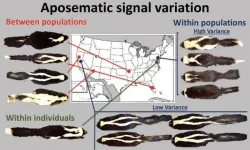(Press-News.org) Eating more ultra-processed foods (UPFs) may be associated with a higher risk of developing cancers of upper aerodigestive tract (including the mouth, throat and oesophagus), according to a new study led by researchers from the University of Bristol and the International Agency for Research on Cancer (IARC). The authors of this international study, which analysed diet and lifestyle data on 450,111 adults who were followed for approximately 14 years, say obesity associated with the consumption of UPFs may not be the only factor to blame. The study is published today [22 November] in the European Journal of Nutrition.
Several studies have identified an association between UPF consumption and cancer, including a recent study which looked at the association between UPFs and 34 different cancers in the largest cohort study in Europe, the European Prospective Investigation into Cancer and Nutrition (EPIC) cohort.
As more evidence emerges about the associations between eating UPFs and adverse health outcomes, researchers from the Bristol Medical School and IARC wanted to explore this further. Since many UPFs have an unhealthy nutritional profile, the team sought to establish whether the association between UPF consumption and head and neck cancer and oesophageal adenocarcinoma (a cancer of the oesophagus) in EPIC could be explained by an increase in body fat.
Results from the team’s analyses showed that eating 10% more UPFs is associated with a 23% higher risk of head and neck cancer and a 24% higher risk of oesophageal adenocarcinoma in EPIC. Increased body fat only explained a small proportion of the statistical association between UPF consumption and the risk of these upper-aerodigestive tract cancers.
Fernanda Morales-Berstein, a Wellcome Trust PhD student at the University of Bristol and the study’s lead author, explained: “UPFs have been associated with excess weight and increased body fat in several observational studies. This makes sense, as they are generally tasty, convenient and cheap, favouring the consumption of large portions and an excessive number of calories. However, it was interesting that in our study the link between eating UPFs and upper-aerodigestive tract cancer didn’t seem to be greatly explained by body mass index and waist-to-hip ratio.”
The authors suggest that other mechanisms could explain the association. For example, additives including emulsifiers and artificial sweeteners which have been previously associated with disease risk, and contaminants from food packaging and the manufacturing process, may partly explain the link between UPF consumption and upper-aerodigestive tract cancer in this study.
However, Fernanda Morales-Berstein and colleagues did add caution regarding their findings and suggest that the associations between UPF consumption and upper-aerodigestive tract cancers found in the study could be affected by certain types of bias. This would explain why they found evidence of an association between higher UPF consumption and increased risk of accidental deaths, which is highly unlikely to be causal.
George Davey Smith, Professor of Clinical Epidemiology and Director of the MRC Integrative Epidemiology Unit at the University of Bristol, and co-author on the paper, said: “UPFs are clearly associated with many adverse health outcomes, yet whether they actually cause these, or whether underlying factors such as general health-related behaviours and socioeconomic position are responsible for the link, is still unclear, as the association with accidental deaths draws attention to.”
Inge Huybrechts, Team head of the Lifestyle exposures and interventions team at IARC, added: “Cohorts with long-term dietary follow-up intake assessments, considering also contemporary consumption habits, are needed to replicate these study’s findings, as the EPIC dietary data were collected in the 1990s, when the consumption of UPFs was still relatively low. As such associations may potentially be stronger in cohorts including recent dietary follow-up assessments.”
Further research is needed to identify other mechanisms, such as food additives and contaminants, which may explain the links observed. However, based on the finding that body fat did not greatly explain the link between UPF consumption and upper-aerodigestive tract cancer risk in this study, Fernanda Morales-Berstein, suggested: “Focussing solely on weight loss treatment, such as Semaglutide, is unlikely to greatly contribute to the prevention of upper-aerodigestive tract cancers related to eating UPFs.”
Dr Helen Croker, Assistant Director of Research and Policy at World Cancer Research Fund, added: “This study adds to a growing pool of evidence suggesting a link between UPFs and cancer risk. The association between a higher consumption of UPFs and an increased risk of developing upper-aerodigestive tract cancer supports our Cancer Prevention Recommendations to eat a healthy diet, rich in wholegrains, vegetables, fruit, and beans.”
The study was funded by the Wellcome Trust; Cancer Research UK; World Cancer Research Fund International; Institut National du Cancer; Horizon 2020 ‘Dynamic longitudinal exposome trajectories in cardiovascular and metabolic non-communicable diseases’ study; University of Bristol Vice Chancellor’s Fellowship; British Heart Foundation and the Medical Research Council.
END
Obesity may not be the only factor to link ultra-processed foods to higher risk of mouth, throat and oesophagus cancers
International study, led by the University of Bristol and the International Agency for Research on Cancer, analysed diet and lifestyle data on 450,111 adults who were followed for approximately 14 years
2023-11-22
ELSE PRESS RELEASES FROM THIS DATE:
Immunotherapy drug is well tolerated in lung cancer patients with limited physical function, study suggests
2023-11-22
For patients with advanced or metastatic non-small cell lung cancer (NSCLC) and limited performance status, an immune checkpoint inhibitor drug called durvalumab is safe and may benefit overall survival, according to a new eClinicalMedicine study by UPMC Hillman Cancer Center researchers.
Performance status, a measure of a patient’s physical function and ability to perform daily activities, is often assessed with the Eastern Cooperative Oncology Group (ECOG) score on a scale of 0 to 5. Higher values describe patients who spend more time confined to a bed or chair and have less ability to care for themselves. Many clinical ...
Strip searching a child without appropriate consent is “sexual abuse,” insists expert
2023-11-22
Strip searching a child without appropriate consent is “sexual abuse,” and should attract heavy sanctions—backed up by legislation—for any UK police officer who does it, insists a leading paediatrician in an opinion piece, published online in the Archives of Disease in Childhood.
Unless the officer(s) can legitimately justify their actions to an independent panel, they should be instantly dismissed and compelled to sign the Sex Offenders Register, writes paediatrician Professor Andy Bush of Imperial College, London.
He cites the “shocking number” of children ...
Skunks’ warning stripes less prominent where predators are sparse, study finds
2023-11-22
Striped skunks are less likely to evolve with their famous and white markings where the threat of predation from mammals is low, scientists from the University of Bristol, Montana and Long Beach, California have discovered.
Skunks’ iconic black and white colouration signals its toxic anal spray. However some skunks show very varied fur colour ranging from all black to thin or thick black and white bands to all white individuals. Variation is huge across the North American continent.
Findings ...
Chlorine disinfectant is no more effective than water at killing off hospital superbug
2023-11-22
One of the primary chlorine disinfectants currently being used to clean hospital scrubs and surfaces does not kill off the most common cause of antibiotic associated sickness in healthcare settings globally, according to a new study.
Research by the University of Plymouth has showed spores of Clostridioides difficile, commonly known as C. diff, are completely unaffected despite being treated with high concentrations of bleach used in many hospitals.
In fact, the chlorine chemicals are no more effective at damaging the spores when used as a surface disinfectant – than using water with no additives.
Writing in the journal Microbiology, the study’s authors ...
Rice receives $2.5M grant to support inclusive STEM education
2023-11-21
HOUSTON – (Nov. 21, 2023) – The Howard Hughes Medical Institute (HHMI) awarded Rice University with $2.5 million spanning over five years as part of its Driving Change initiative designed to connect research universities that are working to build inclusive learning environments for students in science, technology, engineering and mathematics (STEM).
“I’m honored and grateful to the Howard Hughes Medical Institute that Rice University was selected for the Driving Change initiative,” said Amy Dittmar, Howard R. Hughes Provost and executive vice president for academic affairs. “Rice has laid the groundwork for student ...
Medical AI tool from UF, NVIDIA gets human thumbs-up in first study
2023-11-21
A new artificial intelligence computer program created by researchers at the University of Florida and NVIDIA can generate doctors’ notes so well that two physicians couldn’t tell the difference, according to an early study from both groups.
In this proof-of-concept study, physicians reviewed patient notes — some written by actual medical doctors while others were created by the new AI program — and the physicians identified the correct author only 49% of the time.
A team of 19 researchers from NVIDIA and the University of Florida said ...
Getting to the root of visceral gut pain
2023-11-21
MSU has a satellite uplink/LTN TV studio and Comrex line for radio interviews upon request.
Researchers at Michigan State University may have discovered why visceral pain is so common in people who have experienced inflammation in their guts, including patients with irritable bowel syndrome, or IBS.
Working with mouse models, MSU physiologists showed that nervous system cells known as glia can sensitize nearby neurons, causing them to send pain signals more easily than they did prior to inflammation.
“The glia drop the threshold for activating a neuron,” said MSU Research Foundation Professor Brian Gulbransen, whose research team authored the new report in the ...
How AI could help optimize nutrient consistency in donated human breast milk
2023-11-21
A team of University of Toronto Engineering researchers, led by Professor Timothy Chan, is leveraging machine learning to optimize the macronutrient content of pooled human donor milk recipes.
The researchers introduce their data-driven optimization model in a new paper published in Manufacturing and Systems Operations Management.
Chan and his team worked with Mount Sinai Hospital’s Rogers Hixon Ontario Human Milk Bank — which provides donor milk to preterm and sick babies who are hospitalized across Ontario — as well as Dr. Debbie O’Connor, a professor at the Temerty ...
Dwarf galaxies use 10-million-year quiet period to churn out stars
2023-11-21
Contact: Morgan Sherburne, morganls@umich.edu
Images
ANN ARBOR—If you look at massive galaxies teeming with stars, you might be forgiven in thinking they are star factories, churning out brilliant balls of gas. But actually, less evolved dwarf galaxies have bigger regions of star factories, with higher rates of star formation.
Now, University of Michigan researchers have discovered the reason underlying this: These galaxies enjoy a 10-million-year delay in blowing out the gas cluttering up their environments. Star-forming regions are able to hang on to their gas and dust, allowing more stars to coalesce ...
New report highlights vital contribution of ‘virtual schools’ for children in care
2023-11-21
A new study highlights the vital contribution of ‘virtual schools’ for children in care and recommends ten ways to improve their educational outcomes.
The research, by the University of Exeter and the National Association of Virtual School Heads (NAVSH), shows strong disparities in progress and attainment for children in care depending on where they live. They found these differences are not driven by neighbourhood deprivation but by patchy distribution of school places, confused funding policies and variable regulation.
As a result, some virtual schools have difficulty ...
LAST 30 PRESS RELEASES:
Injectable breast ‘implant’ offers alternative to traditional surgeries
Neuroscientists devise formulas to measure multilingualism
New prostate cancer trial seeks to reduce toxicity without sacrificing efficacy
Geometry shapes life
A CRISPR screen reveals many previously unrecognized genes required for brain development and a new neurodevelopmental disorder
Hot flush treatment has anti-breast cancer activity, study finds
Securing AI systems against growing cybersecurity threats
Longest observation of an active solar region
Why nail-biting, procrastination and other self-sabotaging behaviors are rooted in survival instincts
Regional variations in mechanical properties of porcine leptomeninges
Artificial empathy in therapy and healthcare: advancements in interpersonal interaction technologies
Why some brains switch gears more efficiently than others
UVA’s Jundong Li wins ICDM’S 2025 Tao Li Award for data mining, machine learning
UVA’s low-power, high-performance computer power player Mircea Stan earns National Academy of Inventors fellowship
Not playing by the rules: USU researcher explores filamentous algae dynamics in rivers
Do our body clocks influence our risk of dementia?
Anthropologists offer new evidence of bipedalism in long-debated fossil discovery
Safer receipt paper from wood
Dosage-sensitive genes suggest no whole-genome duplications in ancestral angiosperm
First ancient human herpesvirus genomes document their deep history with humans
Why Some Bacteria Survive Antibiotics and How to Stop Them - New study reveals that bacteria can survive antibiotic treatment through two fundamentally different “shutdown modes”
UCLA study links scar healing to dangerous placenta condition
CHANGE-seq-BE finds off-target changes in the genome from base editors
The Journal of Nuclear Medicine Ahead-of-Print Tip Sheet: January 2, 2026
Delayed or absent first dose of measles, mumps, and rubella vaccination
Trends in US preterm birth rates by household income and race and ethnicity
Study identifies potential biomarker linked to progression and brain inflammation in multiple sclerosis
Many mothers in Norway do not show up for postnatal check-ups
Researchers want to find out why quick clay is so unstable
Superradiant spins show teamwork at the quantum scale
[Press-News.org] Obesity may not be the only factor to link ultra-processed foods to higher risk of mouth, throat and oesophagus cancersInternational study, led by the University of Bristol and the International Agency for Research on Cancer, analysed diet and lifestyle data on 450,111 adults who were followed for approximately 14 years





